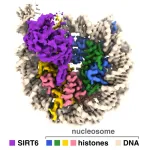(Press-News.org) Along their eight arms, octopuses have highly sensitive suckers that allow methodical explorations of the seafloor as they search for nourishment in a “taste by touch” approach. Squids, on the other hand, use a much different tactic to find their next meal: patiently hiding until they ambush their prey in swift bursts.
In a unique analysis that provides a glimpse into the origin stories of new animal traits, a pair of research studies led by University of California San Diego and Harvard University scientists has traced the evolutionary adaptations of octopus and squid sensing capabilities. The studies, featured on the cover of the April 13 issue of Nature, reveal evolutionary links to human brain receptors.
Researchers with Ryan Hibbs’ newly established laboratory in the School of Biological Sciences at UC San Diego (formerly based at the University of Texas Southwestern Medical Center) and Nicholas Bellono’s lab at Harvard analyzed octopuses and squids, animals known as cephalopods, through a comprehensive lens that spanned atomic-level protein structure to the entire functional organism. They focused on sensory receptors as a key site for evolutionary innovation at the crossroads of ecology, neural processing and behavior.
By looking at the way octopuses and squids sense their marine environments, the researchers discovered new sensory receptor families and determined how they drive distinct behaviors in the environment. With cryo-electron microscopy technology, which uses cryogenic temperatures to capture biological processes and structures in unique ways, they showed that adaptations can help propel new behaviors.
“Cephalopods are well known for their intricate sensory organs, elaborate nervous systems and sophisticated behaviors that are comparable to complex vertebrates, but with radically different organization,” said Hibbs, a professor in the Department of Neurobiology. Hibbs brings expertise on the structure of a family of proteins in humans that mediate communication between brain neurons and other areas such as between neurons and muscle cells. “Cephalopods provide striking examples of convergent and divergent evolution that can be leveraged to understand the molecular basis of novelty across levels of biological organization.”
In one Nature study, the research teams described for the first time the structure of an octopus chemotactile (meaning chemical and touch) receptor, which octopus arms use for taste-by-touch exploration. These chemotactile receptors are similar to human brain and muscle neurotransmitter receptors, but are adapted through evolution to help evaluate possible food sources in the marine environment.
“In octopus, we found that these chemotactile receptors physically contact surfaces to determine whether the animal should eat a potential food source or reject it,” said Hibbs. “Through its structure, we found that these receptors are activated by greasy molecules, including steroids similar to cholesterol. With evolutionary, biophysical and behavioral analyses, we showed how strikingly novel structural adaptations facilitate the receptor’s transition from an ancestral role in neurotransmission to a new function in contact-dependent chemosensation of greasy environmental chemicals.”
The second Nature study focused on squid and their wholly different ambush strategy for capturing food. The researchers combined genetics, physiology and behavioral experiments to discover a new class of ancient chemotactile receptors and determined one structure within the class. They also conducted an evolutionary analysis to link adaptations in squid receptors to more elaborate expansions in octopus. They were then able to place chemotactile and ancestral neurotransmitter receptors on an evolutionary timeline and described how evolutionary adaptations drove the development of new behaviors.
“We discovered a new family of cell surface receptors that offer a rare lens into the evolution of sensation because they represent the most recent and only functionally tractable transition from neurotransmitter to environmental receptors across the entire animal kingdom,” said Hibbs. “Our structures of these unique cephalopod receptors lay a foundation for the mechanistic understanding of major functional transitions in deep evolutionary time and the origin of biological novelty.”
Hibbs says the pair of new studies offers an excellent example of how curiosity in interesting creatures can lead to insights important for all of biology, namely how proteins—life’s building blocks—adapt to mediate new functions and behaviors.
“These studies are a great example of what being a scientist is all about—wonder, exploration and understanding how things work,” he said.
END
Tracking a new path to octopus and squid sensing capabilities
Research reveals that the octopus explores the marine environment with sensing features that are evolutionarily related to human brain receptors
2023-04-14
ELSE PRESS RELEASES FROM THIS DATE:
Trees in savanna areas of Cerrado produce three times more bark than species in forest areas
2023-04-14
In tropical regions of the planet, savannas and forests often coexist in the same area and are exposed to the same climate. An example is the Cerrado, a Brazilian biome that includes several types of vegetation, from broad-leaved and sclerophyllous in dense woodland or shrubland (cerrado sensu stricto) to semi-evergreen in closed-canopy forest (cerradão), as well as grassland with scattered shrubs (campo sujo) and even semi-deciduous seasonal forest.
Areas of cerradão develop in the absence of fire, in both poor and moderately fertile soil (dystrophic to mesotrophic).
This coexistence intrigues botanists and ecologists ...
Wayne State researcher receives $1.95 million NIH grant to study impact of inositol homeostasis on essential cellular functions
2023-04-14
DETROIT – A researcher from Wayne State University’s Department of Biological Sciences has received a five-year, $1.95 million grant from the National Institute of General Medical Sciences of the National Institutes of Health to identify mechanisms that regulate inositol synthesis in mammalian cells and determine the cellular consequences of inositol depletion.
Inositol is a type of sugar that is essential for the viability of eukaryotic cells. Myo-inositol is the precursor of all inositol compounds, which play pivotal roles in cell signaling and metabolism. Consistent with its importance, a disturbance of inositol homeostasis ...
Head and neck, breast cancer research highlights University of Cincinnati AACR abstracts
2023-04-14
University of Cincinnati Cancer Center researchers will present more than a dozen abstracts at the American Association for Cancer Research Annual Meeting 2023, held in Orlando, Florida, April 14-19, including findings that could advance treatments for head and neck and breast cancers.
Enzyme shows promise as target to treat HPV negative head and neck cancer
Vinita Takiar’s lab in UC’s Department of Radiation Oncology studies how to improve radiation therapy for head and neck cancer patients.
Julianna Korns, a doctoral student working in Takiar’s lab, and her colleagues study an enzyme called Plk1 that allows healthy cells to divide ...
Scientists develop new way to measure wind
2023-04-14
Wind speed and direction provide clues for forecasting weather patterns. In fact, wind influences cloud formation by bringing water vapor together. Atmospheric scientists have now found a novel way of measuring wind – by developing an algorithm that uses data from water vapor movements. This could help predict extreme events like hurricanes and storms.
A study published by University of Arizona researchers in the journal Geophysical Research Letters provides, for the first time, data on the vertical distribution of horizontal winds ...
Ancient DNA reveals the multiethnic structure of Mongolia’s first nomadic empire
2023-04-14
Long obscured in the shadows of history, the world’s first nomadic empire - the Xiongnu - is at last coming into view thanks to painstaking archaeological excavations and new ancient DNA evidence. Arising on the Mongolian steppe 1,500 years before the Mongols, the Xiongnu empire grew to be one of Iron Age Asia’s most powerful political forces - ultimately stretching its reach and influence from Egypt to Rome to Imperial China. Economically grounded in animal husbandry and dairying, the Xiongnu were famously nomadic, building their empire on the backs of horses. ...
2022 Tongan volcanic explosion was largest natural explosion in over a century, new study finds
2023-04-14
The 2022 eruption of a submarine volcano in Tonga was more powerful than the largest U.S. nuclear explosion, according to a new study led by scientists at the University of Miami Rosenstiel School of Marine, Atmospheric, and Earth Science and the Khaled bin Sultan Living Oceans Foundation.
The 15-megaton volcanic explosion from Hunga Tonga-Hunga Ha'apai, one of the largest natural explosions in more than a century, generated a mega-tsunami with waves up to 45-meters high (148 feet) along the coast of Tonga’s Tofua Island and waves up to 17 meters (56 feet) on Tongatapu, ...
How does an aging-associated enzyme access our genetic material?
2023-04-14
UNIVERSITY PARK, Pa. — New research provides insight into how an enzyme that helps regulate aging and other metabolic processes accesses our genetic material to modulate gene expression within the cell. A team led by Penn State researchers have produced images of a sirtuin enzyme bound to a nucleosome—a tightly packed complex of DNA and proteins called histones—showing how the enzyme navigates the nucleosome complex to access both DNA and histone proteins and clarifying how it functions in humans and other animals.
A paper describing the results appears April 14 in the journal ...
Aston University develops software to untangle genetic factors linked to shared characteristics among different species
2023-04-14
Has potential to help geneticists investigate vital issues such as antibacterial resistance
Will untangle the genetic components shared due to common ancestry from the ones shared due to evolution
The work is result of a four-year international collaboration.
Aston University has worked with international partners to develop a software package to help scientists answer key questions about genetic factors associated with shared characteristics among different species.
Called CALANGO (comparative analysis with annotation-based genomic ...
Single-use surgical items contribute two-thirds of carbon footprint of products used in common operations
2023-04-14
A new analysis of the carbon footprint of products used in the five most common surgical operations carried out in the NHS in England shows that 68% of carbon contributions come from single-use items, such as single-use gowns, patient drapes and instrument table drapes. Published by the Journal of the Royal Society of Medicine, the analysis highlights significant carbon contributors were the production of single use items and their waste disposal, together with processes for decontaminating reusable products.
Researchers ...
Study: Anti-obesity medications could be sold for lower prices
2023-04-14
ROCKVILLE, Md.—New research shows that several anti-obesity medications could be manufactured and profitability sold worldwide at far lower estimated lower prices compared to their high costs, according to a new study in Obesity, The Obesity Society’s (TOS) flagship journal.
“Access to medicine is a fundamental element of the human right to health. While the obesity pandemic grows, especially amongst low-income communities, effective medical treatments remain inaccessible for millions in need. Our study highlights the inequality in pricing that exists for effective anti-obesity medications, ...
LAST 30 PRESS RELEASES:
Tracing the quick synthesis of an industrially important catalyst
New software sheds light on cancer’s hidden genetic networks
UT Health San Antonio awarded $3 million in CPRIT grants to bolster cancer research and prevention efforts in South Texas
Third symposium spotlights global challenge of new contaminants in China’s fight against pollution
From straw to soil harmony: International team reveals how biochar supercharges carbon-smart farming
Myeloma: How AI is redrawing the map of cancer care
Manhattan E. Charurat, Ph.D., MHS invested as the Homer and Martha Gudelsky Distinguished Professor in Medicine at the University of Maryland School of Medicine
Insilico Medicine’s Pharma.AI Q4 Winter Launch Recap: Revolutionizing drug discovery with cutting-edge AI innovations, accelerating the path to pharmaceutical superintelligence
Nanoplastics have diet-dependent impacts on digestive system health
Brain neuron death occurs throughout life and increases with age, a natural human protein drug may halt neuron death in Alzheimer’s disease
SPIE and CLP announce the recipients of the 2025 Advanced Photonics Young Innovator Award
Lessons from the Caldor Fire’s Christmas Valley ‘Miracle’
Ant societies rose by trading individual protection for collective power
Research reveals how ancient viral DNA shapes early embryonic development
A molecular gatekeeper that controls protein synthesis
New ‘cloaking device’ concept to shield sensitive tech from magnetic fields
Researchers show impact of mountain building and climate change on alpine biodiversity
Study models the transition from Neanderthals to modern humans in Europe
University of Phoenix College of Doctoral Studies releases white paper on AI-driven skilling to reduce burnout and restore worker autonomy
AIs fail at the game of visual “telephone”
The levers for a sustainable food system
Potential changes in US homelessness by ending federal support for housing first programs
Vulnerability of large language models to prompt injection when providing medical advice
Researchers develop new system for high-energy-density, long-life, multi-electron transfer bromine-based flow batteries
Ending federal support for housing first programs could increase U.S. homelessness by 5% in one year, new JAMA study finds
New research uncovers molecular ‘safety switch’ shielding cancers from immune attack
Bacteria resisting viral infection can still sink carbon to ocean floor
Younger biological age may increase depression risk in older women during COVID-19
Bharat Innovates 2026 National Basecamp Showcases India’s Most Promising Deep-Tech Ventures
Here’s what determines whether your income level rises or falls
[Press-News.org] Tracking a new path to octopus and squid sensing capabilitiesResearch reveals that the octopus explores the marine environment with sensing features that are evolutionarily related to human brain receptors






